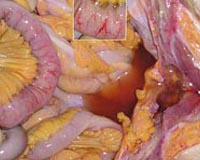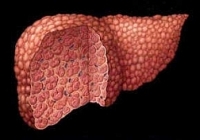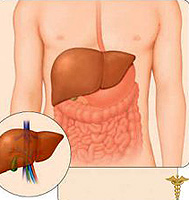The pathogenesis of ascite largely depends on the specific reason that causes it. In patients suffering from severe cirrotic leaning of the liver, an increase in pressure in the veins system, which provide blood flow to the liver.
Content
Modern medicine does not have complete knowledge regarding the details of the development of ascites in each specific clinical observation. However, we know many factors responsible for the appearance of a liquid in the abdominal cavity in patients with severe cirrotic liver damage.
Portal Hypertension syndrome
In case of liver cirrhosis, a characteristic symptom complex is developing, characterized as portal hypertension syndrome, due to a significant increase in pressure in the veins system, providing blood flow from most organs located in the abdominal cavity to the liver. This happens due to the fact that the liver «filter», intended for the indigenous biochemical transformation of various chemical compounds entering the organ, not able to skip through itself the amount of fluid, the transit of which provided a healthy liver in normal conditions.
Some liquid blood «squeezed out» through the venous wall and penetrates the first phase of his forced «Resettlement» to the surrounding fabrics, and with the development of certain additional adverse factors, may fall into the abdominal cavity. The difficulty of the Passage of blood in a portal vein leads to a cluster of the tissue fluid in the abdominal organs, as a result of which they are induced, the lymphatic vessels are significantly expanding. Increased pressure in the carrier vein is accompanied by an increased fluid yield into the lymphatic channel. But still, in the development of ascites, a decisive role belongs not to a violation of the passability in the system of a portal vein, but the difficulties of blood-ceottock at the level of liver lobes. The mechanical obstacle to the post-sinusoidal outflow of blood due to morphological disorders of the structure of the organ under cirrhosis, plays the most important role in the accumulation of ascites, although it is not the only one.
Severe lesion of liver cells
 In patients with severe lesions of liver cells, protein-sensing function is developing. The liver becomes incapable of adequately replenishing the natural and pathological loss of the most valuable fraction of the protein spectrum in the human body - albumin. They belong to K «Light» Molecular structures, have a variety of functional responsibilities, including the sufficient level of oncotic blood pressure, which contributes to the holding of its liquid part in the vascular bed. With hypoalbuminemia, the liquid seeks to leave the clearance of venous vessels of the portal system, which contributes to the development of ascites.
In patients with severe lesions of liver cells, protein-sensing function is developing. The liver becomes incapable of adequately replenishing the natural and pathological loss of the most valuable fraction of the protein spectrum in the human body - albumin. They belong to K «Light» Molecular structures, have a variety of functional responsibilities, including the sufficient level of oncotic blood pressure, which contributes to the holding of its liquid part in the vascular bed. With hypoalbuminemia, the liquid seeks to leave the clearance of venous vessels of the portal system, which contributes to the development of ascites.
The content of sodium and water in the body is regulated by the kidneys under the control of the antidiuretic hormone pituitary. The damaged liver is not able to sufficiently neutralize the blood circulating antidiuretic hormone, which contributes to the water delay in the vascular bed. Renal plasma and glomerular filtration indicators are reduced, the reabsorption of sodium and the excretion of potassium increases.
An increase in their reabsorption in the kidney channels due to the impact of aldosterone has important in the mechanism of sodium and water delay. Hyperldosteroneism under the cirrhosis of the liver arises due to the increased secretion of the hormone of the adrenal cortex against the background of the incidence of an effective amount of circulating blood and reduced inactivation in hepatocytes hyperaldosteroneism arises, first of all, as an answer to a decrease in the effective amount of circulating plasma, which is an activator of the Rhenin-angiotensin-aldosterone system, responsible for restoring the proper level of volienia.
Insufficiency of the lymphatic system
The leading role in the formation of ascites in patients with cirrhosis of the liver, of course, belongs to the lymphatic system deficiency. The liver is formed up to 70% of the entire body lymph, which is transported to the venous system of a large circulation of blood circulation. Due to the decomptionation of the venous liver system during cirrhosis, it becomes impossible perfusion of the required amount of portal blood through the organ.
The load on the lymphottock system increases sharply, which is forced to reimburse the insufficiency of venous outflow and takes the maximum possible (up to a tenfold increase in volume) the amount of fluid from the organ in the form of «liver» lymphs. But, being under long «Pressing», due to pronounced disorders of the liver hemolymphodynamics, the lymphatic system, ultimately, ceases to cope with the proceeds. Lymphatic capillaries, small vessels and trunk trunks are expanding, there is disorganization of normal microlimphocyerculation at the level of lymphangions, as a consequence of the valve insufficiency increases stagnation of lymph, lymphatic hypertension. Dynamic lymphottock deficiency develops, leading to a fluid sinking from the surface of the liver into the abdominal cavity. This leads to a situation that clinicians call «Playing liver», When the peashing of lymphs through a serous sheath of the liver (glissonov capsule) leads to the appearance of ascites. For some time, this liquid can adequately absorb parietal peritoneum, but these compensatory capabilities cannot be infinite.
The fact is that for moving the liquid from the abdominal cavity and returning it to the vascular channel corresponds to the same system of lymphoottock, which by the time of the development of ascite is at least in the state of sub payment, and additional load in the form of an increase in the amount of fluid that must be moved From the abdominal cavity, leads to its full insolvency.
The participation of the lymphatic system in the genesis of breeding hemodynamics in patients with cirrhosis is so significant, which led to the formation of the concept of portal lymphatic hypertension. Undoubtedly, there are other mechanisms for the development of ascitic syndrome, which we do not yet know or cannot assess the degree of their significance due to insufficient awareness.









